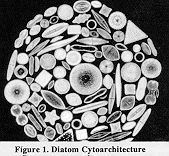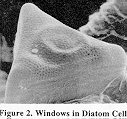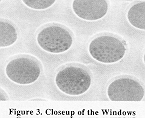
It was a miracle of rare device,
A sunny pleasure dome with caves of ice!
Samuel Taylor Coleridge on the Pleasure Palace of Kubla Khan 
From the evolutionary view of the biosphere, the Kingdom Protista—whichcomprises the unicellular eukaryotic organisms (protozoa, algae, and slimemolds)—is primitive to "higher" life forms—multicellularanimals and plants—yet among its members is manifested the greatestcomplexity of cell structure known. Exemplary of this point are the diatomaceousalgae (Bacilliariophycea), whose cytoarchitecture exhibits perhaps themost exquisite geometry seen in the natural world [1](figure 1).Diatoms are truly microorganisms—too small to be seen with the nakedeye. With an average diameter of 25 microns (10-6 meters), fourindividual diatoms could be laid across the breath of a human hair.  In terms of population numbers, however, diatoms are a huge component of the earth's biota,making up about 90% of all living organisms in the ocean (there are also speciesof diatoms inhabiting fresh water). These and other photosynthetic phytoplanktonconstitute the trophic base of the ocean's food chains, responsible for theproduction of some 130,000 million tons of organic carbon per year. As such,diatoms play a vital role in the earth's ecology. And to those students ofnature who are receptive to it, they give us a lesson in the philosophy ofdesign and its significance. In terms of population numbers, however, diatoms are a huge component of the earth's biota,making up about 90% of all living organisms in the ocean (there are also speciesof diatoms inhabiting fresh water). These and other photosynthetic phytoplanktonconstitute the trophic base of the ocean's food chains, responsible for theproduction of some 130,000 million tons of organic carbon per year. As such,diatoms play a vital role in the earth's ecology. And to those students ofnature who are receptive to it, they give us a lesson in the philosophy ofdesign and its significance.
Diatoms have been a marvel to microscopists since Ernst Haeckel's mid-19thcentury descriptions of the first of what now amount to some 10,000 speciesliving today, and in the fossil record. The fascination is with thegeometrically intricate structure of the cell wall. As for other kinds of algaeand the cells of plants per se, the cell wall of diatoms contains cellulose. The special orientation of the cellulose microfibrils is guided by anarray of microtubules in the cortical cytoplasm, which in turn becomes adeterminant of cell shape. In concert with the deposition of silica (as silicicacid, Si[OH]4, taken up from the environmental milieu) a topographyof elaborately sculpted patterns of grooves, flanges, and spicules isestablished; as these are inlaid with hydrous silicon oxide, the diatoms'opaline shells, or tests, are produced. This patterned framework is repeatedlyperforated with minute pores, or fenestrae (figures 2,3), through whichpseudopodial cytoplasmic processes pass in the course of nutrient acquisitionand locomotion. The result is one of astonishing beauty—perfect symmetry,top to bottom, left to right, and front to back, in a plethora of geometricshapes—circles, squares, triangles, ovals, stars, and rectangles (figure1). (Note, silica is the stuff of which opals are made [more mundane substancescomposed of silica are sand, quartz, chert, and glass]. The biogenic opalinestructure of diatome tests indicates that millions of years would notnecessarily be required for the formation of these gemstones as it is commonlypurported.) Like other algae, diatoms contain the green pigment chlorophyll, butthe presence of additional pigments, notably the yellowish xanthophylls, givethese organisms a rich golden brown hue. The artistry is further embellished bythe way in which diatoms reproduce, which is usually by cell division, but witha twist. Diatom cell walls consist of almost identical halves which fit togetherlike a box fits into its lid. With division, each half separates and produces aslightly smaller shell that fits within the old one, a scheme reminiscent ofRussian Matrishka dolls. Subsequent divisions result in a succession of eversmaller daughter cells, until a minimum size limit is reached. A process ofsexual reproduction, by means of spores (gametes), is then activated, givingrise to diatoms of the original size.   Altogether, diatoms are aptly referred to as jewels of the sea. Fabergé'sfinest creations pale in comparison to those of the Creator! Diatom shell structure is species specific; i.e., all organisms of the samespecies have essentially the same shell shape and infrastructure (though thereare minor individual variations, so that no two diatoms are exactly alike), butthe pattern is different for each species. Thus, as a character of taxonomicsignificance, it may be inferred that diatom shell structure is determined,ultimately, by genetic information. Meanwhile, the geometric diversity displayedappears to be non-adaptational—i.e., undiminished by natural selection.This is beauty for its own sake, unfettered by evolutionary pragmatism! Nonetheless, for all their aesthetic qualities, diatoms are also a practicalenvironmental resource. As photosynthetic autotrophs, they manufacture their ownnutrition, which in turn represents a substantial percentage of the earth'sannual production of organic carbon. In the process they are significantconsumers of carbon dioxide and are responsible for the production of much ofthe earth's atmospheric oxygen. Their syntheses include that of a very highquality oil (comparable to peanut, linseed, and cotton oils) occupying up to 10%of the cell's volume (the diatoms use this oil as a metabolic energy reserve).While chemically different from that found in oil fields per se, it isnot unlikely that fossil beds of diatoms containing billions of cubic feet ofthese microbes have contributed to the earth's hydrocarbon deposits. As primaryproducers, diatoms constitute the major food item for many fish (supplying amongother nutrients most of the vitamin D found in fish oils) and other aquaticanimals, including the largest of all—whales. Diatomaceous earth (depositsof their sedimented siliceous tests—diatomite rock from fossil beds,fullers' earth from more recent sediments) has industrial application as a fineabrasive and is used in filtering and insulating materials. When absorbed bydiatomite (which Alfred Nobel knew as Kieselguhr), nitroglycerinebecomes stable and thus we have dynamite. Diatoms have proven extremely usefulas guide fossils to the geologists' location of petroleum deposits for the oiland gas industry. Ecologically, they significantly impact the inorganic chemicalconcentrations of the aquatic environment, especially of silica, nitrates, andphosphates, playing a major role in their cycling between the animate andinanimate components of the biosphere. Under certain circumstances (e.g.,fertilizer runoff, resultant phosphate pollution and microbial blooms), this canhave the adjunctive function of purifying fouled water supplies. Besides diatoms, planktonic organisms for which silica is a structuralcomponent, are the silicoflagellates and some of the radiolarians. A group ofprotists resembling diatoms in their form are the polythalamian foraminifera.They differ from diatoms in having tests of calcium carbonate. The obviousfunction of these shells, siliceous or calcareous, is that of an exoskeletalsupport system, one perhaps adjunctive to their buoyancy, though most protistsget along very well without them (see, e.g., the shell-less radiolarians). Geometric form is also seen in purely physical (abiotic) systems, as in thecase of crystals. Indeed, most solid matter has orderly atomic arrangement andis of crystalline structure when a solid is formed gradually from a fluid (anotable exception is glass). Outward form is bounded by smooth, planar,symmetrically arranged surfaces (facets) which develop in response todirectional forces within the growing crystal itself. Each chemicalelement (or compounds thereof, e.g., salts and oxides) tends to crystallize in adefinite and characteristic form. The apparently infinite variability of formexhibited by snowflakes—every snow crystal is unique in its preciseconfiguration—is due to the unlimited variation in the specificmicro-weather conditions under which they are assembled (combinatorily, thenumber and distribution of ice nucleation centers in a developing snowflake areinfinitely variable, thus the chance of a repeat becomes mathematicallyimpossible). Engineers, who by and large are less prone to flights of evolutionary fancythan biological theorists, note that one characteristic of functional design iselegance. [1] Where natural systems are the example,reference is to an essential elegance, one more fundamental than mereappearance; beautiful outward form is a reflection of economical design. To aconsideration of the design principle, it is significant that the geometryexhibited by diatoms goes above and beyond the aforementioned intrinsicorganizational properties of physical matter—e.g., crystalline geometry—inits informational determinants, which, as embodied in the organisms'genetics (vice supra), are extrinsic to the components of the shellstructures themselves. The intricate micromorphology of these organisms isneither predictable nor constrained by the physical qualities of its constituentelements, noting that biogenic silica as opal has no inherent crystallinestructure (cf. lithogenic silica), but in the solid state is amorphous. Cf. thecase of snowflake formation where I = 0 (see below), information is a qualitywhich when imposed on a dynamic system reduces an indefinite number of possibleoutcomes to a singularity—as we have it in the species specific form ofdiatom shells. Thus, if I0 = 0 (when no information is available, I1 0 (when information is gained), P0 is the probability forpossible outcomes, P1 = 1 (when, as a result of specifyinginformation, a single outcome is selected), then: 0 (when information is gained), P0 is the probability forpossible outcomes, P1 = 1 (when, as a result of specifyinginformation, a single outcome is selected), then: I = -k lnP or delta I=-kln (P1/P0) = I1- I0In the totality of our human experience, there is but one source ofmeaningful information, and that is intelligence. Proponents of chaos theorymight have it otherwise. To a non-theistic evolutionist, who would perforcegainsay the impingement of creative intelligence on the natural world, what isperceived as design in biological systems is attributable to the organizationalproperties of matter itself, or a stochastic trial and error process in theevolution of the genetic base. Yet the same evolutionist has no problem withidentifying artifacts such as arrowheads for what they are and accordinglyattributing to them an intelligent source, with the conviction that suchgeometric shapes, albeit much less complex than those manifested by diatoms, donot form by mindless chance. Why are diatoms, so exquisitely complex, sosingularly beautiful to study? The answer is in Romans 1:20: "For the invisible things of Him fromthe creation of the world are clearly seen, being understood by the things thatare made, even His eternal power and Godhead; so that they are without excuse." In all their aesthetic intricacy, could diatoms be simply the calling cardof the Master Designer? With that in mind, we dedicate this paper to the memoryof Dr. Richard Bliss, who was so quick to comprehend and appreciate design innature— its source—and who was so effective in educating his students—Kthrough faculty colleagues—to that principle.
 |

